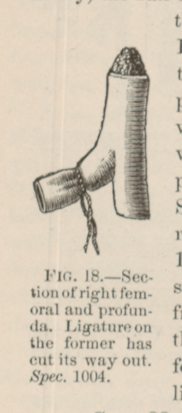Title: Curler, I.
Source text: The Medical and Surgical History of the War of the Rebellion. (1861-65.), Part 3, Volume 2 (Washington, DC: Government Printing Office, 1883), 44.
Civil War Washington ID: med.d2e2663
TEI/XML: med.d2e2663.xml
CASE 97.—Private I. Curler, Co. G, 5th Michigan, was wounded at Fair Oaks, May 31, 1862, and admitted to Hygeia Hospital, Fort Monroe, four days afterwards. Surgeon R. B. Bontecou, U. S. V., reported: "Gunshot wound of femoral artery, the ball entering the anterior and middle portion of the right thigh and passing out opposite posteriorly, going close to the inside of the femur. The temperature of the limb was good, although the artery at the ankle beat feebly. Hæmorrhage from both wounds occurred on June 10th, and returned in a few hours. An unsuccessful attempt to find the artery below the wound was made, and I tied the femoral, as I supposed, above the profunda; but pulsation being so strong in the artery exposed below the ligature, further search was made and the profunda was found unusually high up. This was also tied, and no hæmorrhage returned. The foot, before the operation warm, now became cold; but by the aid of external heat its temperature returned on the following day. The patient was a fine healthy looking young fellow. He was transferred to New York by steamer on June 12th." Surgeon S. W. Gross, U. S. V., contributed the specimen shown in the annexed cut (FIG. 18) and reported the result of the case as follows: "The patient was admitted to DeCamp Hospital, David's Island, New York, June 15th, and was placed under the charge of Acting Assistant Surgeon W. K. Cleveland. At the time of his admission the ligature had come away but the wound had not united. On June 17th, profuse hæmorrhage occurred from the profunda femoris, around which a ligature was cast. The patient, however, had lost so much blood that he succumbed two hours after the operation." The specimen (FIG. 18) consists of a small section of the femoral and profunda arteries, and shows the femoral blocked up with a clot at the seat of the ligature, also the ligature around the profunda, where another clot was formed.
